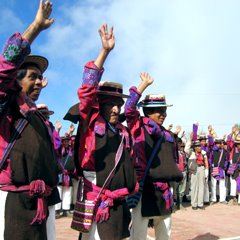
Fighting for the Legitimacy of Customary Law
In Canada nobody is above our official legal system and to the extent that these laws are applied equally to all this remains fair and democratic. But in Canada legal enforcement is often applied in a discriminatory manner in tandem with racial profiling. Many people feel the mistreatment and targeting of Aboriginal youth represents the indoctrination of prejudices within the police force. Last July, four young Native women were harassed and threatened by Police for singing traditional songs in a park in Vancouver's Eastside. Among other consequences, the subjugation of Aboriginal communities meant the subordination of the customary and restorative Indigenous legal system. Although smaller crimes contained within the Aboriginal community are sometimes dealt with independently of official Canadian law, this overriding system blankets the actions of all individuals, but not always with just accord.
The situation in Guatemala is quite different since the indigenous communities are more prominent in the national population and have arguably retained more of their autonomy. However, the confrontation between customary Indigenous law and the official legal system of the state is ongoing, often characterized as a battle for legitimacy and authority. A recent article in Latin American Press addresses this issue. link to article
Defensoria Maya is an activist group that fights against economic, political and social discrimination against Guatemala's Indigenous population. Its members are pushing for the recognition of Indigenous law within the official system and their campaign is supported by many prominent social organizations, including the Supreme Court. Beyond negotiating for their inclusion in the formation and application of official laws, Defensoria Maya is calling for an independent system, with distinct values, institutions and procedures, that would guarantee the right of Indigenous people to be tried by their own laws. It seems that many people feel the persistence and strength of ethnocentric behavior among the non-Indigenous class negates the possibility for mutual reconciliation. It is clear that any past efforts to unify the distinct segments of Guatemalan society have failed. What would social unity look like in such a divided nation and considering the unknown consequences is it really desirable? Can two very different systems of law coexist in any society?
Returning to Canada with the same questions presents a new series of complications and further questions. In most larger towns and cities across BC, the Native communities have been given reservation land and subsidies as part of the provincial conpensation scheme. Even if establishing customary Indigenous law within the reservation communities was a beneficial course of action, that would not prevent the discrimination that occurs in urban zones. These issues are merely specific manifestations of the larger problem of enduring anti-Native sentiment within our society. The situation in the Downtown Eastside and crisis of homelessness are further examples of "cracks in the foundation" of our society. Many have come to refer to the Downtown Eastside as an Indigenous Ghetto since it is home to the largest number of off-reserve Natives in the country. The escalating number of homeless, the drastic reductions in single occupancy housing units and the continued discrimination against Aboriginal Youth are all details of a cycle of neglect, originating from a dominant social trajectory that values wealth over equality.
last301


0 Comments:
Post a Comment
<< Home